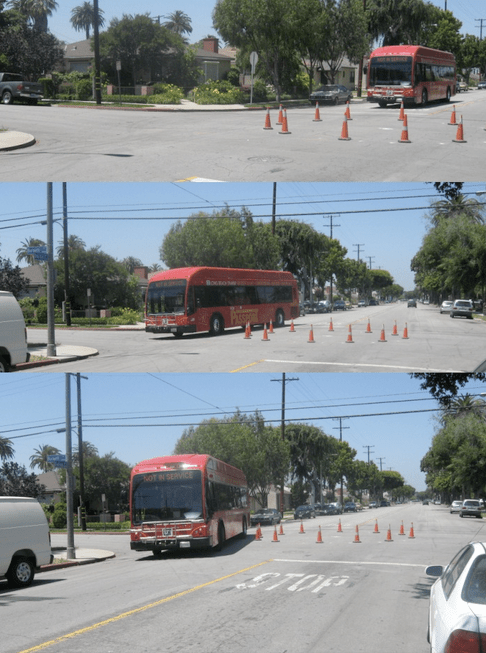Here's the thing: I love roundabouts and pretty much hate most traffic signals. And here's why: the former are simply better on all every level possible.
And, frankly put, the folks who are dealing with the Daisy Bike Boulevard and its proposed three roundabouts should take a step back and regard not only substantial evidence from other cities, but the recent test run the Long Beach Public Works Department conducted about a week ago.
There are two main concerns regarding the roundabouts to be on Daisy at 25th, Burnett, and Hill Street: safety and the ability for fire trucks, buses, and the Wrigley Christmas Tree Lane Parade floats to actually go through the roundabouts.
Let's deal with the first one--by far the most complex.
The thing with traffic lights and stop signs within in neighborhoods is the I-can-and-will-get-through mentality: Drivers habitually race through lights since a green gives them a false sense of security (who honestly looks anywhere but forward when they have a green?) and a yellow means they better hurry up (heaven forbid we are stalled for 15 seconds of our lives). Stop signs, meanwhile, act more and more as "slow down" signs--particularly in our state, home of the "California roll"--that equally make drivers habitually run them because "there is never anyone crossing here." Both ultimately lead to a genuine lack of regarding one's surroundings, not actual safety--hence the birth of the always disturbing T-bone accident.
Roundabouts encourage very basic human behaviors: eye contact, communication, waves, hell, even a mouthed, "Thanks." Because roundabouts avoid the two dangers previously mentioned: the false sense of safety (you have no green so I suggest you look at who's around you) and rolling through something you shouldn't (the main thrust of roundabouts are yields, not stops).
My deep support of roundabouts could very well stem from my more radical enjoyment of "naked streets" a la Hans Monderman, the traffic engineer who hated traffic lights with such a fiery passion that he eradicated them--literally. In Drachten, he took the busiest intersection--some 20,000 cars a day--and turned it into... A roundabout. His logic? He once told the New York Times "Who has the right of way? I don't care. People here have to find their own way, negotiate for themselves, use their own brains."
It is that precise logic which makes roundabouts work. And our deep-seated fear of letting people use their own brains often gets the best of us--and rightfully so. When it comes to expressing one's self, well, do as you please; when it comes to our safety, we are a bit more Draconian in nature and want to (think we can) prevent everything.
Think this is crazy? Check out Poynton, England, just northwest of Manchester, where engineers reconfigured the busiest intersection in town with two roundabouts and no lights--repeat: no lights. The three years before its creation? 17 accidents. Since its creation in 2008? Four.
Now let's tackle the Christmas Parade fears.
Members of Long Beach Public Works, the 7th Council District, and the Wrigley Area Neighborhood Association, in partnership with Long Beach Transit, decided they would do a test run. They took a transit Passport bus--10 feet longer than our trash trucks and fire trucks--and using cones as an outline for the roundabouts, tested the bus's ability to get around.
Success.
And it should be noted: Public Works engineers noticed that even with the cones, traffic slowed down. In the words of Bike Long Beach, "The circles exist to calm traffic, making the road a safer place for all users – whether they are riding a bike, a minivan, a trash truck, or a parade float."
While we wait for construction on the Daisy Bike Boulevard to begin in early 2014, can we also get some more roundabouts installed? Pretty please with a cherry on top.








